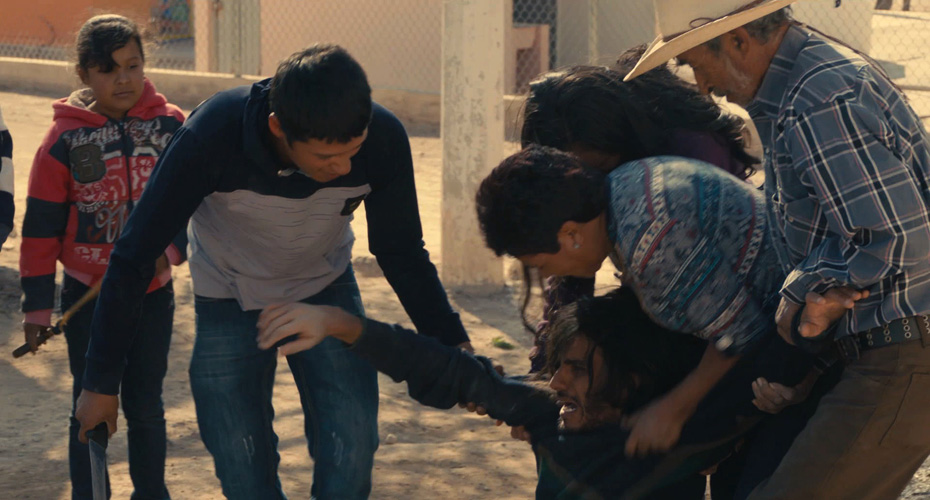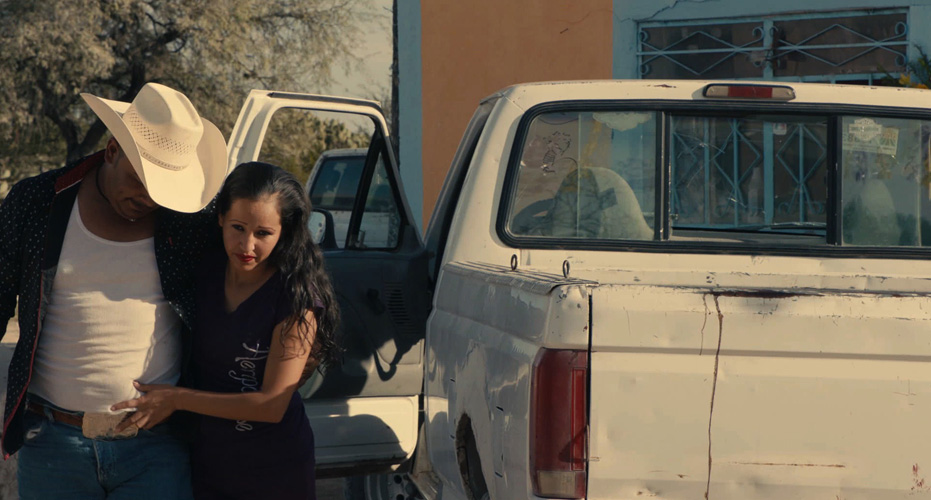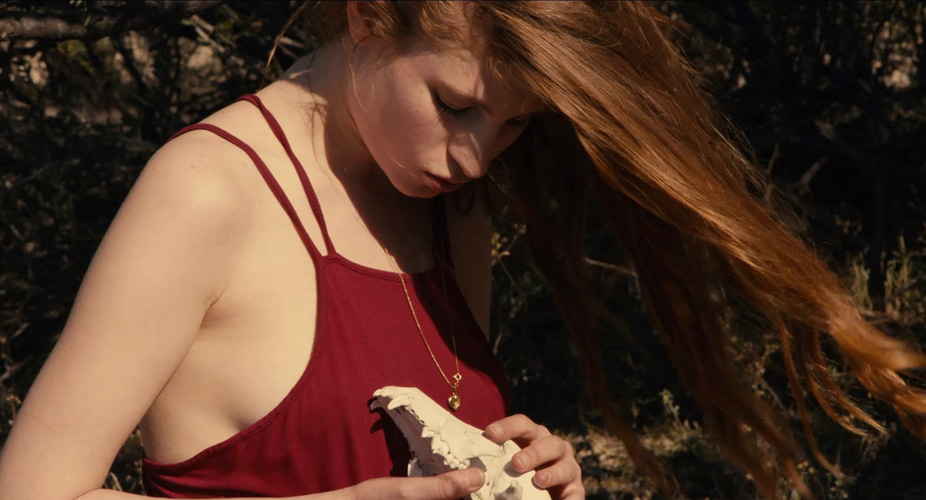Dismantling the organism has never meant killing yourself, but rather opening the body to connections that presuppose an entire assemblage, circuits, conjunctions levels and thresholds, passages and distributions of intensity, and territories and deterritorializations measured with the craft of a surveyor.
Ciguri is the very mystery of all poetry.
Gilles Deleuze and Félix Guattari, A Thousand Plateaux
Clarisse Hahn’s (b. and b. Paris, 1973) Mescaline (2017), is a narrative about the consequences of the mutually ignored crossing of the margins of an encounter. The events unfold in a small town in the Wirikuta desert in the northern center Mexican State of San Luis Potosí. It features a young European couple on a “Mystical Tourism” trip in search for the magic cactus, the peyote, in desert. They are cultured and curious and have traveled to Mexico following the steps of Antonin Artaud and Henri Michaux, looking for the secrets of the earth that can be revealed in the experience offered by peyote intake. For over 5000 years, peyote has been considered by Huichol and other indigenous peoples as a sacred food. Its consumption produces hallucinations during religious ceremonies, which they believe helps them develop healing capacities and communication with their gods. For them, all living beings have a soul and thus the peyote plant possesses a spirit and wisdom to share. For decades, travelers after Artaud – but also Carlos Castañeda, the American anthropologist who wrote extensively about his experiences with peyote – have traveled to Catorce to embark on a spiritual journey in the desert.
The impulse that drove Artaud and all those who have followed him to the Huichol desert was a utopian quest for a primitive and mystic culture rich in cults and myths that could be an alternative to decadent European culture and rationality. Artaud was the first to use the peyote experience as a means to break with identity, a “tearing” in the sense of a struggle against structures that channel subjectivity attempting to break with Cartesian thought toward non-representational logic. His was a search for a language as not yet cauterized by reason, a “schizo-langauge” that subverts codes by being embedded in corporeality. The potential for bridging the dichotomy between inner and outer landscape, body and mind, material and spiritual enabled by peyote-induced hallucinations, had an alleged therapeutic function (although after Artaud we know mescalin is dangerous for schizophrenics). In Artaud’s account of his own experience of peyote intake, the body becomes an inner landscape, a dislocated assemblage, a heap of organs. His visions inspired Gilles Deleuze and Félix Guattari’s concept of the Body without Organs (BwO): a state of corporeal liberation toward an extra-dimensional inner landscape based on the disturbance of the specular limits and the dissolution between the internal and external, which enables human existence on a formless plane and the destruction of both, signifiance and subjectification.

Mescaline, Mescaline, a film by Clarisse Hahn, France / 2017 / Fiction / 45’04 / Les films du Bélier
When Artaud traveled to witness the peyote ritual on a commission by the Mexican government in 1936, he had to wait for 28 days until the ceremony was performed for him by the Huichol sorcerers. In contrast, Agathe and Mehedi, the protagonists of Mescaline, like the other 5,000 tourists who visit every year the Sierra Tarahumara to consume peyote, are led to the desert and instructed on how to harvest and cut the cactus without the context of the ritual. Nowadays, a substance used for spiritual healing is used as a recreational drug; as a consequence, intakers are endangered when they consume mescalin without supervision or guidance, and this is the case of Agathe and Mehdi. The inhabitants of the town where the narrative unfolds, endure without much choice the uninvited presence of mystical tourists who come to their town in false hopes of corporeal liberation and encounters with Ciguri. One of the extraordinary things about this film is how Hahn – who has cultivated a relationship with the inhabitants of the village for many years and whom are also protagonists in the film – turns the gaze not inward, toward the experience of mescalin itself, like her predecessors in the Tarahumara mountains did, but outward and around. This crucial – decolonial – move renders legible how mescalin affects the native community’s life through patterns and practices of colonial power. Hahn therefore shows how the mystical tourists’ presence in the Sierra Tarahumara perpetuates the Modern colonialist relationship to non-Western cultures based on exoticization. In other words, in Mescalin, the community and the tourists become present to each other as mutual projections and this inevitably leads to destruction and violence.

Mescaline, Mescaline, a film by Clarisse Hahn, France / 2017 / Fiction / 45’04 / Les films du Bélier
While completely high, Agathe sends signals that are misperceived, and Mehdi comes into the town to disturb the community’s essential subsistence structures. In a truly open effort to be friendly, Agathe jumps in a truck with 5 men for whom her amicable attitude, white skin, and pockets full of foreign money mean privilege and a history of colonization and racism between them. Intoxicated by alcohol and mescaline, she wakes up the next day to realize that she has been gang raped. At the end of the film, we see her with an empty gaze and mute, unable to process what she has just been through, as she is only able to focus on devouring a chewing gum flavored popsicle she buys off the road. We know the whereabouts of Mehdi when a young man finds Agathe’s lace underwear at the site of the rape (the back of a truck in the desert) and brings it over home to the women who symbolically burn it on the stove. As we get a glimpse of the community’s everyday life, we realize that the women although angry with their men, are not economically independent and cannot send them to hell for having fooled around with the foreign woman. They are also infuriated by Mehdi, whom high on mescaline, comes to disturb the goats in their pen and ends up taking a swim on the town’s drinking water tank; the women lynch him benignly, perhaps as he is saved from more severe punishment for his mischief by his brown skin. Hahn’s film thus sheds light on the mutual idealization and exoticization that still permeates in relationships between Western and non-Western cultures and how the Other – as under the yoke of colonialism – keeps on appearing as an inaccessible consciousness and thus as an absence, hiding while unveiling as sheer violence.
Irmgard Emmelhainz
